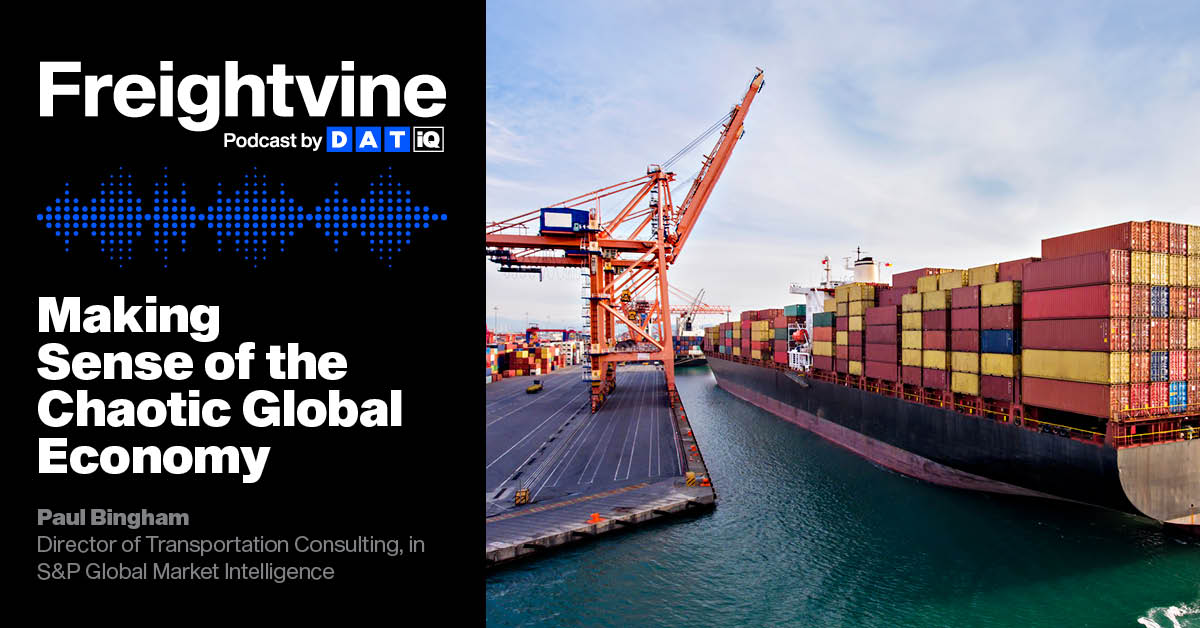The ongoing pandemic, rising fuel costs, inflation and Russia’s invasion of Ukraine are wreaking havoc on the economy, roiling freight markets and global supply chains.
To understand the impact of these global factors on transportation and logistics in North America, DAT Chief Scientist Chris Caplice interviewed Paul Bingham, S&P Global Market Intelligence’s director of transportation consulting, on the Freightvine podcast by DAT iQ.
Five key takeaways from their insightful conversation reveal silver linings and emerging opportunities for shippers, freight brokers and carriers.
Capacity demand outweighs supply
This comes as no surprise to anyone with a role in supply chain or transportation and logistics. The problem has been constant for two years and counting. Carriers and freight brokers have been investing in technology to improve efficiency, but that can only take them so far.
“We are, at best, months away of really making substantial headway against the problems that we face with the congestion that is still clogging the system and the inefficiency of use of both capital and labor and all of the extra costs and high rates that people are paying as a consequence,” Bingham noted during the podcast. “There’s no silver, magic solution to make it go away in a month or two.”
Early adopters of technology will gain market share, predicted Dr. Caplice and Bingham. As shippers look for inroads or advantages, intermediaries that lack advanced technology could get squeezed out as those with better technology and greater reach take command.
Labor struggles and equipment shortages persist
These two challenges are universal, but modes experiencing a greater share of difficulties are ocean shipping, trucking and rail. Bingham points out that 10% of container ship capacity is currently not in use; it’s sitting in the ocean waiting to get into ports due to land-side bottlenecks. There’s simply no way for goods to move from ship to shore and be trucked to the final destination. Docks are struggling with labor and will again be hit with labor negotiations this summer. Warehouses don’t have enough workers. Carriers don’t have enough drivers, and so on.
Supply chains are working
One high point discussed by Bingham and Dr. Caplice is that supply chains are actually working. Collectively, the system is handling record volumes of freight. Carriers are seeing record-high rates and profits. However, demand increased by more than capacity and caused service to suffer. Consumers have been experiencing the impacts of capacity shortages.
Shippers looking for alternatives
Shippers are discontent with the lack of capacity and carriers not meeting their service commitments. As such, they are looking for alternatives. Some are charting cargo vessels to bypass traditional ocean container fleets. Others are looking at increasing domestic manufacturing or moving factories closer to home. Supply chain managers are also looking at country diversification to avoid one nation disrupting their entire flow of goods if a natural disaster, war or other shutdown happens. While Bingham and Dr. Caplice noted these are all worthwhile efforts, they stress the fact that globalization is not going away.
High inflation and energy prices impact demand for foods
Inflation is at record highs and oil prices have skyrocketed – especially since the Russian invasion of Ukraine. Shippers and carriers must factor rising costs into all transportation modes, which, ultimately, raises prices for all goods that consumers buy. Consumers will trim their budgets for non-essential goods, but this could be a silver lining. Capacity might open back up in some freight sectors and help unclog ports, which will help retailers fill inventories and work toward supply chain recovery.
2022 Outlook: Tough challenges ahead with some bright spots
There’s no question that 2022 will be another rough year for the global supply chain and freight markets. Capacity continues to be a challenge, but the high cost of fuel and inflation may tamper demand and allow some catchup for durable goods. Technology will also continue to play a role in solving the capacity crunch and alleviating some pain, but don’t expect a quick fix. Even so, there are reasons for optimism in the mid and long term.
For a deeper dive into how all of the above factors are impacting the global freight market, listen to the full episode of Freightvine.



